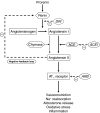Application of direct renin inhibition to chronic kidney disease
- PMID: 20490905
- PMCID: PMC2887501
- DOI: 10.1007/s10557-010-6232-1
Application of direct renin inhibition to chronic kidney disease
Abstract
Purpose: Chronic kidney disease has serious implications with a high risk for progressive loss of renal function, increased cardiovascular events as well as a substantial financial burden. The renin-angiotensin-aldosterone system (RAAS) is activated in chronic kidney disease, especially in diabetes and hypertension, which are the leading causes of chronic kidney disease. Angiotensin converting enzyme (ACE) inhibitors and angiotensin receptor blockers (ARBs) decrease the rate of progression of diabetic and non-diabetic nephropathy and are recommended therapy for chronic kidney disease.
Methods: Key clinical trials supporting the use of ACE inhibitors and ARBs in chronic kidney disease are discussed. Recent developments in our understanding of RAAS biology and the use of direct renin inhibition are reviewed in the context of their potential impact on the prevention and management of chronic kidney disease.
Results: Despite the clinical success of ACE inhibitors and ARBs the rates of mortality and progression to renal failure remain high in these patient populations. ACE inhibitor or ARB monotherapy, in doses commonly used in clinical practice does not result in complete suppression of the RAAS. Aliskiren, a direct renin inhibitor, offers a novel approach to inhibit the RAAS in chronic kidney disease.
Conclusions: High dose ARB therapy or combination therapies with ACE inhibitors and ARBs have shown beneficial effects on surrogate markers of chronic kidney disease. Early data based on urinary protein excretion rates as a surrogate marker for renal function suggest a possibly novel role for aliskiren alone or in combination with ARBs in chronic kidney disease.
Figures



Similar articles
-
Rationale for combination angiotensin receptor blocker and angiotensin-converting enzyme inhibitor treatment and end-organ protection in patients with chronic kidney disease.Am J Nephrol. 2008;28(3):372-80. doi: 10.1159/000112269. Epub 2007 Dec 12. Am J Nephrol. 2008. PMID: 18073461 Review.
-
Optimal antagonism of the Renin-Angiotensin-aldosterone system: do we need dual or triple therapy?Drugs. 2010 Jul 9;70(10):1215-30. doi: 10.2165/11537910-000000000-00000. Drugs. 2010. PMID: 20568830 Review.
-
Update on role of direct renin inhibitor in diabetic kidney disease.Ren Fail. 2014 Jul;36(6):963-9. doi: 10.3109/0886022X.2014.900425. Epub 2014 Mar 31. Ren Fail. 2014. PMID: 24678880 Review.
-
[Direct renin inhibitor aliskiren in the treatment of cardiovascular and renal diseases].Vnitr Lek. 2010 Feb;56(2):120-6. Vnitr Lek. 2010. PMID: 20329582 Review. Czech.
-
Combination renin-angiotensin system blockade with the renin inhibitor aliskiren in hypertension.J Renin Angiotensin Aldosterone Syst. 2009 Dec;10(4):185-9. doi: 10.1177/1470320309342733. Epub 2009 Jul 17. J Renin Angiotensin Aldosterone Syst. 2009. PMID: 19617273
Cited by
-
Short- and long-term physiologic and pharmacologic control of blood pressure in pediatric patients.Integr Blood Press Control. 2011;4:35-44. doi: 10.2147/IBPC.S17265. Epub 2011 May 24. Integr Blood Press Control. 2011. PMID: 21949637 Free PMC article.
-
Discovery of VTP-27999, an Alkyl Amine Renin Inhibitor with Potential for Clinical Utility.ACS Med Chem Lett. 2011 Aug 9;2(10):747-51. doi: 10.1021/ml200137x. eCollection 2011 Oct 13. ACS Med Chem Lett. 2011. PMID: 24900262 Free PMC article.
-
Peripheral blood-derived endothelial progenitor cell therapy prevented deterioration of chronic kidney disease in rats.Am J Transl Res. 2015 May 15;7(5):804-24. eCollection 2015. Am J Transl Res. 2015. PMID: 26175844 Free PMC article.
-
Aliskiren Hemifumarate Proliposomes for Improved Oral Drug Delivery: Formulation Development, In Vitro and In Vivo Permeability Testing.Molecules. 2022 Jul 28;27(15):4828. doi: 10.3390/molecules27154828. Molecules. 2022. PMID: 35956779 Free PMC article.
-
Discovery of TAK-272: A Novel, Potent, and Orally Active Renin Inhibitor.ACS Med Chem Lett. 2016 Sep 12;7(10):933-938. doi: 10.1021/acsmedchemlett.6b00251. eCollection 2016 Oct 13. ACS Med Chem Lett. 2016. PMID: 27774132 Free PMC article.
References
-
- K/DOQI clinical practice guidelines for chronic kidney disease: evaluation, classification, and stratification. Am J Kidney Dis 2002; 39:S1−266. - PubMed
-
- MMWR Prevalence of chronic kidney disease and associated risk factors—United States, 1999–2004. Morb Mortal Wkly Rep. 2007;56:161–165. - PubMed
-
- United States Renal Data System.Available at: www.usrds.org.
Publication types
MeSH terms
Substances
LinkOut - more resources
Full Text Sources
Medical
Miscellaneous

